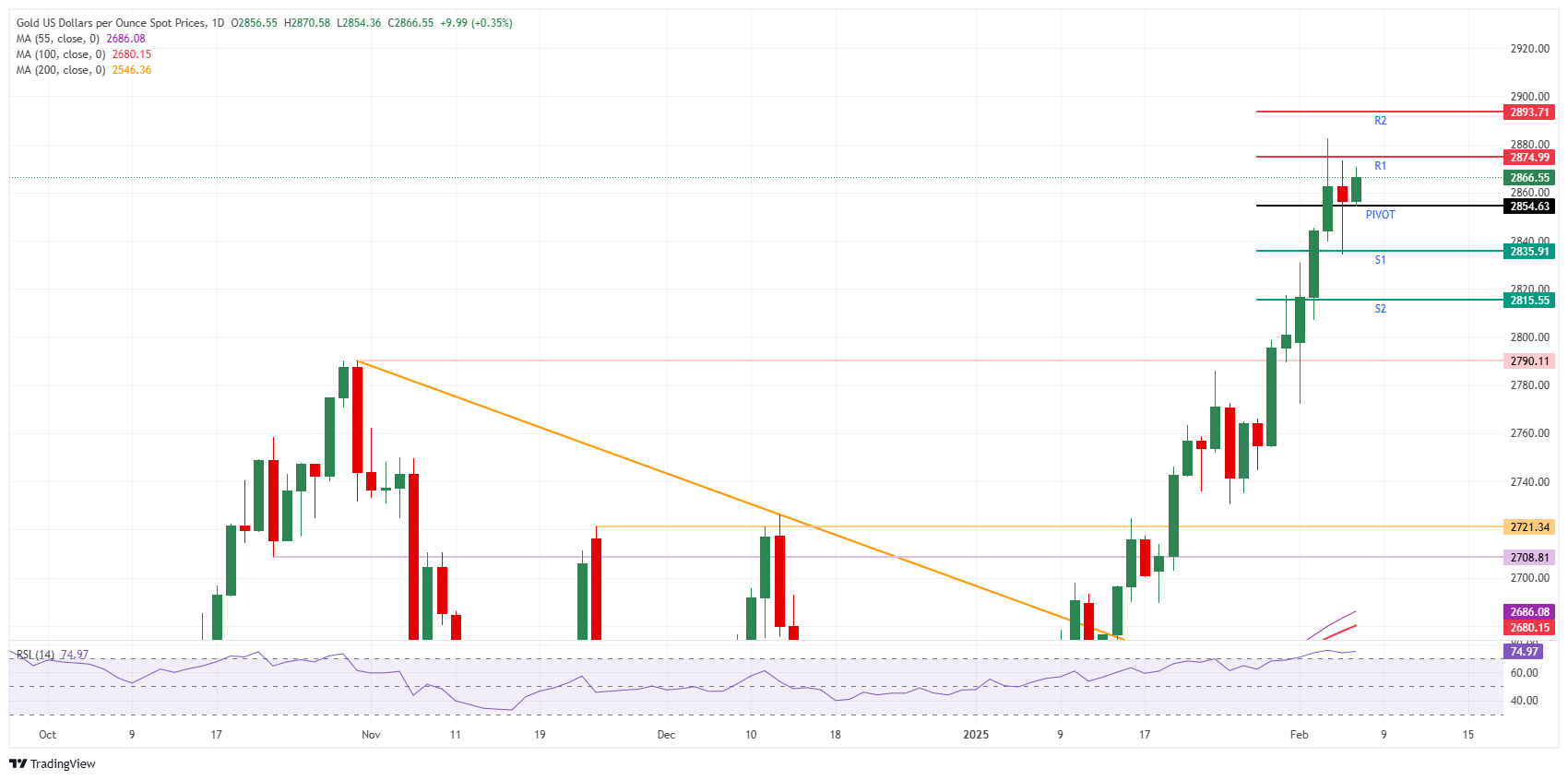- Gold’s rally picks up where it left off on wednesday, after Thursday’s hiccup.
- Markets are excited for the upcoming US Nonfarm Payrolls release on Friday.
- Gold could print a new all-time high on Friday if Nonfarm Payrolls disappoints.
Gold’s price (XAU/USD) is pushing higher and trades back up near $2,867 at the time of writing on Friday, after its small downbeat performance on Thursday. The pickup in the rally comes ahead of the US Nonfarm Payrolls (NFP) report later in the day. A weaker number would benefit Gold, with rate cut odds from the Federal Reserve (Fed) increasing.
Meanwhile, headlines emerged on Friday that China’s central bank, the People’s Bank of China (PBOC), has expanded its Gold reserves for a third month in a row. Even at fresh all-time high prices, the central bank bought roughly 0.16 million troy ounces in January, Bloomberg reports. Meanwhile, threats from US President Donald Trump to slap more tariffs on the Eurozone and other countries are keeping Gold supported as a safe haven for investors should the tariff war escalate further.
Daily digest market movers: Tariff headline risk
- Gold reserves held by the People’s Bank of China rose by 0.16 million troy ounces last month, according to data released Friday. The central bank resumed adding Gold reserves in November after a six-month halt that ended an 18-month buying spree, Bloomberg reports.
- The US-China trade war, fears that President Donald Trump will follow through on threats to impose tariffs on other nations, and his unconventional geopolitical possible interventions are supporting Gold’s role as a safe haven in uncertain times. The bull run looks set to continue, with prices likely to hit $3,000 an ounce within three months, Citigroup Inc. said in a note, Bloomberg reports.
- Zimbabwe’s Gold output rose to 3,134.34 kg in January, up from 2,375.32 kg a year earlier, Fidelity Gold Refinery said on Friday in an emailed statement, Reuters reported. It was mostly the smaller-scale miners who were good for the increase in output, while the larger mines declined in production.
- At 13:30 GMT, the US Nonfarm Payrolls employment report for January is due. Expectations are for 170,000 new workers in the month compared to 256,000 in December. However, broad expectations are for a much softer number, according to several bank analysts and forecasters.
Technical Analysis: $3,000 marker as holy grail
With the Nonfarm Payrolls release on Friday, it is clear that if Gold hits a new all-time high, it will be due to a very weak number in employment data. However, as usual, caution needs to be taken with this build-up in expectations. Even a number in line with consensus could be enough to disappoint markets on their downside expectations, triggering a knee-jerk reaction with Gold facing some profit-taking ahead of the end of the week.
The Pivot Point level on Friday is the first nearby support at $2,854, followed by the S1 support at $2,835. From there, S2 support should come in at $2,815. In case of a correction, the bigger $2,790 level (the previous high of October 31, 2024) should be able to catch any falling knives.
On the upside, the R1 resistance comes in at $2,874, just slightly below the current all-time high at $2,882. In case the rally can pick up where it left off, the upside level to beat in terms of daily pivotal levels is the R2 resistance near $2,893 ahead of $2,900 as a big figure.

XAU/USD: Daily Chart
Interest rates FAQs
Interest rates are charged by financial institutions on loans to borrowers and are paid as interest to savers and depositors. They are influenced by base lending rates, which are set by central banks in response to changes in the economy. Central banks normally have a mandate to ensure price stability, which in most cases means targeting a core inflation rate of around 2%. If inflation falls below target the central bank may cut base lending rates, with a view to stimulating lending and boosting the economy. If inflation rises substantially above 2% it normally results in the central bank raising base lending rates in an attempt to lower inflation.
Higher interest rates generally help strengthen a country’s currency as they make it a more attractive place for global investors to park their money.
Higher interest rates overall weigh on the price of Gold because they increase the opportunity cost of holding Gold instead of investing in an interest-bearing asset or placing cash in the bank. If interest rates are high that usually pushes up the price of the US Dollar (USD), and since Gold is priced in Dollars, this has the effect of lowering the price of Gold.
The Fed funds rate is the overnight rate at which US banks lend to each other. It is the oft-quoted headline rate set by the Federal Reserve at its FOMC meetings. It is set as a range, for example 4.75%-5.00%, though the upper limit (in that case 5.00%) is the quoted figure. Market expectations for future Fed funds rate are tracked by the CME FedWatch tool, which shapes how many financial markets behave in anticipation of future Federal Reserve monetary policy decisions.
Financial Market Newsflash
No financial news published today. Check back later.










